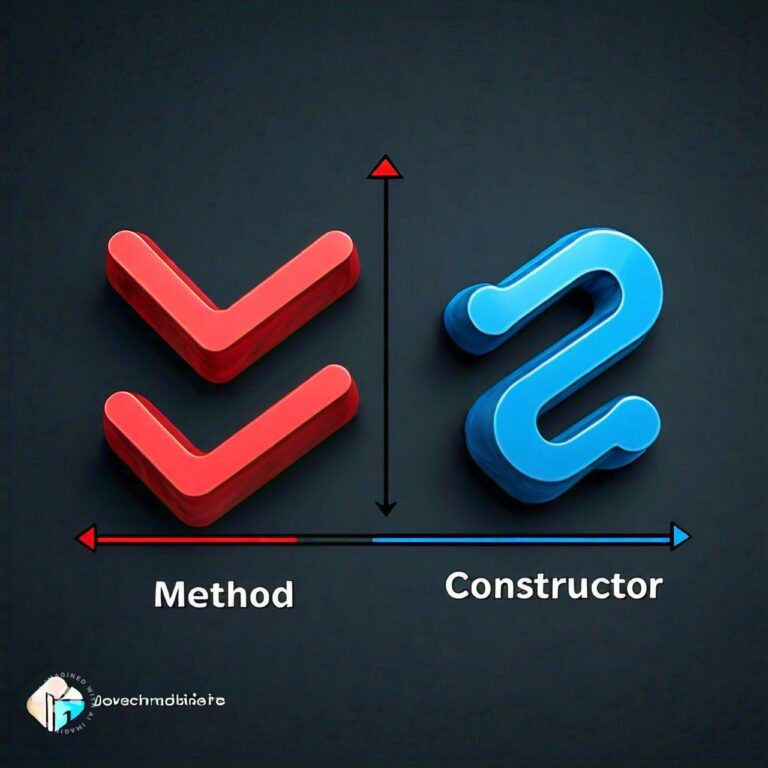
Differences Between Method and Constructor in Java
In Java programming, methods and constructors are two fundamental concepts that allow developers to build well-structured, reusable, and efficient code. While both methods and constructors perform important roles, they differ in their purpose and behavior. A method in Java is a block of code that performs a specific task, and it can be called whenever needed in the program. Methods are used to implement the logic of an application, manipulate data, and perform operations such as calculations, input/output, and more. Methods can take parameters, return values, and be overloaded to accept different sets of inputs.
A constructor, on the other hand, is a special type of method used to initialize objects in Java. Constructors are automatically called when an object of a class is created and are used to set up initial states for the object, such as assigning values to variables. Unlike regular methods, constructors do not have a return type, not even void. Constructors also share the same name as the class they belong to and are primarily responsible for preparing objects for use. They ensure that the object starts in a valid and usable state by setting default values or performing any necessary setup.
Method Overview
Methods are blocks of code that execute a specific task and can be reused throughout the program. Below are five key aspects of methods in Java.
1. Definition and Purpose of a Method
A method in Java is a block of code written to perform a particular task. Methods allow developers to break down complex programs into smaller, more manageable parts. By writing methods, programmers can group common operations and reuse them throughout their codebase. For instance, a method might calculate the sum of two numbers, print a message to the console, or update the state of an object.
- Task-Oriented: Methods perform specific tasks, such as calculations or updating data.
- Reusable Code: Methods help avoid repetition by allowing code to be reused.
2. Method Syntax and Structure
In Java, a method consists of several key components: the access modifier (e.g., public, private), the return type (e.g., int, void), the method name, a list of parameters (if any), and the method body, which contains the statements to be executed. The syntax of a method looks like this:

- Access Modifier: Determines the method’s visibility (
public,private, etc.). - Return Type: Indicates the type of value returned by the method (e.g.,
int,String,void).
3. Parameters and Return Values
A method can take parameters that act as inputs, allowing it to operate on data passed to it. Methods can also return a value to the caller. If no value needs to be returned, the method's return type is specified as void. For example, the addNumbers() method shown above takes two parameters (int a, int b) and returns their sum as an integer. Methods can return any type of data, including primitive types, objects, or collections.
- Parameters: Inputs that the method operates on.
- Return Value: The result produced by the method, which can be of any data type.
4. Method Overloading
Method overloading is a feature in Java that allows multiple methods in the same class to have the same name but different parameter lists. This enables a method to handle different types or numbers of inputs. For example, a calculateArea() method could be overloaded to calculate the area of a square, rectangle, or circle based on different parameter combinations.
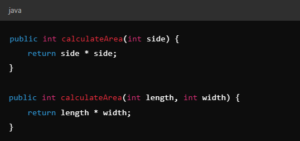
- Method Overloading: Multiple methods with the same name but different parameters.
- Versatile: Allows the same method name to be used for different operations.
5. Static and Instance Methods
In Java, there are two types of methods: static methods and instance methods. Static methods belong to the class and can be called without creating an object, whereas instance methods belong to an object and require an instance of the class to be called. Static methods are often used for utility functions, while instance methods operate on the data of an object.
- Static Method: Belongs to the class and can be called without an object.
- Instance Method: Belongs to an object and requires an instance to be called.
Constructor in Java Overview
Constructors in Java are special methods used to initialize objects. Below are five key aspects of constructors.
1. Definition and Purpose of a Constructor
A constructor is a special method in Java used to initialize a new object of a class. The primary role of a constructor is to set up the initial state of the object by assigning values to instance variables or performing any other necessary setup tasks. Constructors are automatically called when a new object is created using the new keyword.
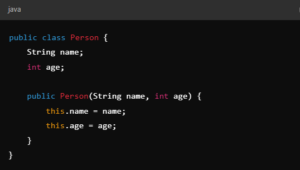
- Object Initialization: Constructors are used to set up the initial state of objects.
- Automatic Call: Invoked automatically when an object is created with
new.
2. Constructor Syntax and Structure
The syntax of a constructor is similar to a method, but there are key differences. Constructors must have the same name as the class and cannot have a return type (not even void). Like methods, constructors can take parameters, allowing for flexible object initialization. For example:
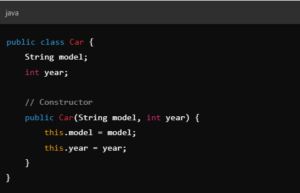
- Same Name as Class: The constructor’s name must match the class name.
- No Return Type: Constructors do not have a return type.
3. Types of Constructors
In Java, there are two main types of constructors: default constructors and parameterized constructors. A default constructor is provided by Java if no other constructors are defined. It does not take any parameters and initializes instance variables to their default values. A parameterized constructor, on the other hand, allows developers to provide specific values for initializing an object when it is created.

- Default Constructor: No parameters, initializes variables to default values.
- Parameterized Constructor: Takes parameters to initialize variables.
4. Constructor Overloading
Just like methods, constructors can be overloaded. Constructor overloading allows multiple constructors in the same class, each with different parameter lists, enabling flexible ways to initialize objects. For example, a class may have one constructor that sets default values and another that allows specific values to be passed in.
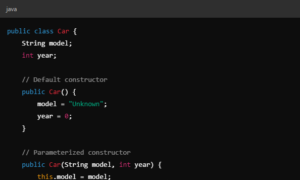
- Overloading: Multiple constructors with different parameter lists.
- Flexible Initialization: Allows objects to be created in different ways.
5. Chaining Constructors (this())
Java allows constructor chaining, where one constructor calls another within the same class using the this() keyword. This is useful for code reuse and ensuring consistency in object initialization. For example, a constructor with fewer parameters might call another constructor with more parameters to handle initialization.
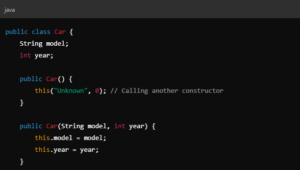
- Constructor Chaining: One constructor calls another using
this(). - Code Reuse: Reduces duplication in initialization logic.
Differences Between Method and Constructor in Java
- Purpose
- Method: Performs specific tasks or operations.
- Constructor: Initializes objects.
- Name
- Method: Can have any name.
- Constructor: Must have the same name as the class.
- Return Type
- Method: Must have a return type (e.g.,
int,void). - Constructor: No return type.
- Method: Must have a return type (e.g.,
- Invocation
- Method: Called explicitly by the programmer.
- Constructor: Called automatically when an object is created.
- Overloading
- Method: Can be overloaded.
- Constructor: Can also be overloaded.
- Return Statement
- Method: May contain a
returnstatement. - Constructor: Cannot return a value.
- Method: May contain a
- Functionality
- Method: Can be static or non-static.
- Constructor: Always non-static.
- Inheritance
- Method: Can be inherited by subclasses.
- Constructor: Not inherited but can be invoked via
super().
- Use of
this- Method: Can use
thisto refer to the current object. - Constructor: Can use
this()to invoke another constructor in the same class.
- Method: Can use
- Default Presence
- Method: No default method is provided by Java.
- Constructor: Java provides a default constructor if no constructors are defined.
Conclusion
In Java, methods and constructors play essential yet distinct roles. Methods are blocks of reusable code designed to perform specific tasks, while constructors are special methods used to initialize objects when they are created. Understanding the differences between methods and constructors is crucial for writing efficient, organized, and functional Java programs. By mastering the concepts of methods and constructors, developers can create flexible, scalable, and well-structured applications that are easy to maintain and extend.
FAQs
Related Topics
- All
- Animals
- Diseases
- Health
- Money
- Politics
© 2024 OnYelp.com. All rights reserved. Terms and Conditions | Contact Us | About us
